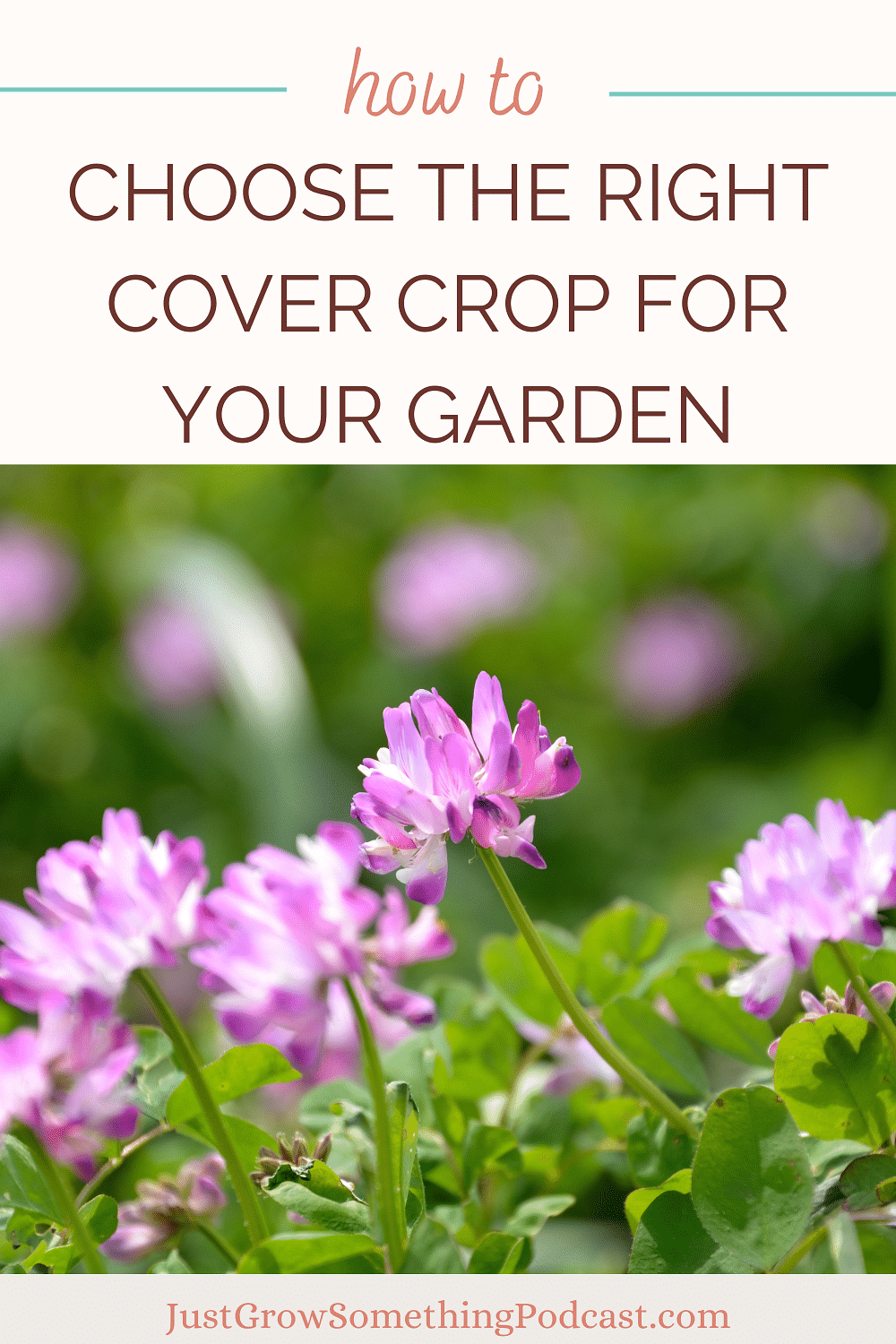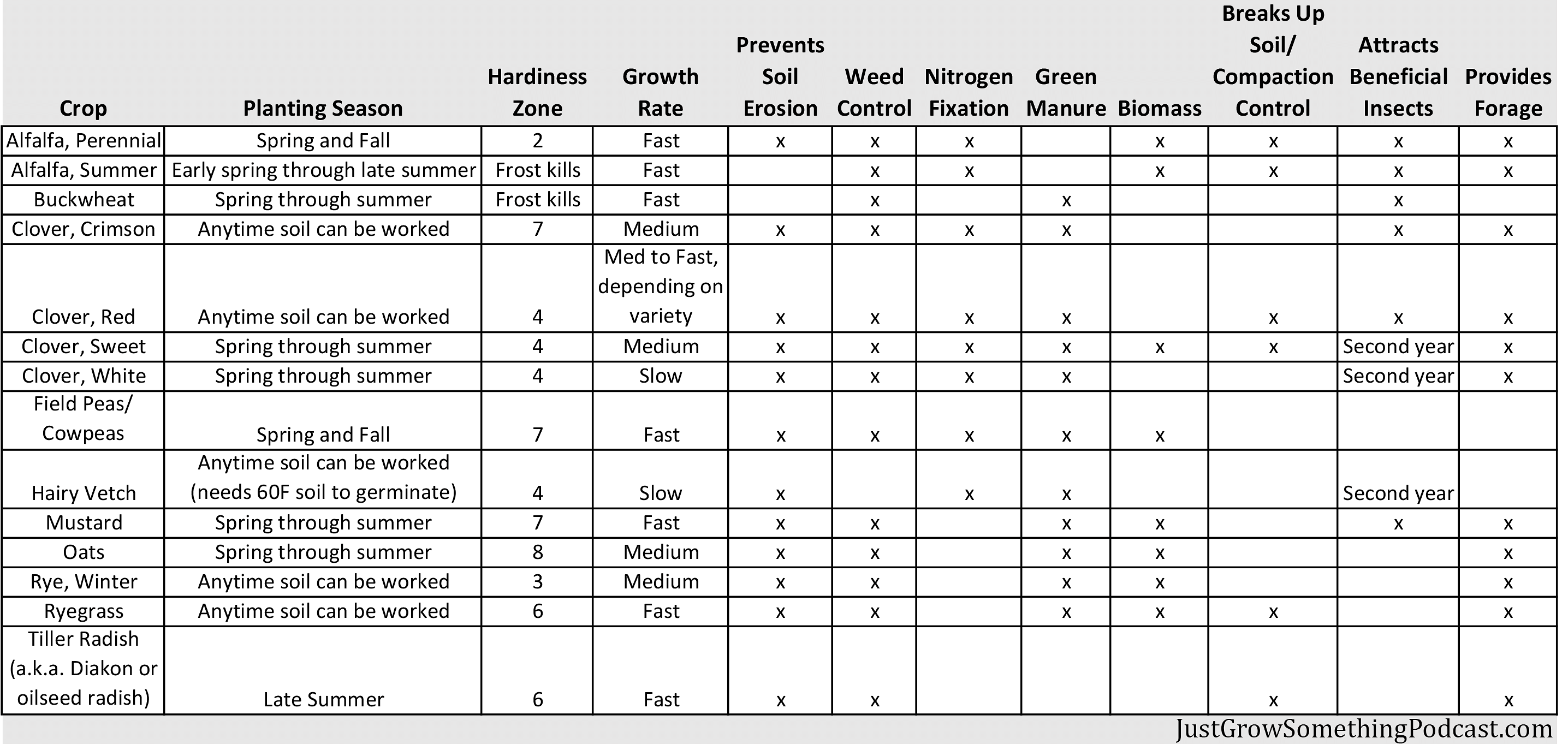
Cover crops are any plant grown in the garden to improve a soil’s physical structure or its fertility or both. Cover crops are also often referred to as green manure. They can be grains, grasses, brassicas, or legumes.

Let’s talk about some of the most popular cover crops we can use in the home garden and then we’ll put them into categories based on our cover cropping goals.
- Summer alfalfa – planted in early spring to late summer, fast growth rate, is not frost tolerant, high forage and biomass yield. Long taproots break up compacted soil and bring up subsurface minerals, adding to soil fertility. High nitrogen fixation and great forage for bees.
- Buckwheat – planted spring to summer, very fast growth rate, not frost tolerant, grows for about a month before being terminated. Great for suppressing weeds between crops in the summer and attracting pollinators when blooming.
- Clover – different types of clover, some more low-growing, some a bit taller. Crimson clover is hardy only through zone 7, the others are hardy to zone 4, so many will survive the winter in colder climates and act as a living mulch. Growth rate ranges from slow to fast depending on type and check most of the boxes on the goals of cover cropping. Crimson and Red clovers can be planted anytime, sweet clover and white clover are planted spring to summer.
- Mustard – fast growing cover crop planted spring through fall, great for weed suppression, building biomass and often acts as pest control to boot, specifically nematodes. Does best in cool conditions but will winter kill in zones 7 and colder so should be planted in spring or as early in fall as possible to really reap the benefits.
- Oats – not only edible, but a great cover crop. I used to plant oats between my strawberry plants and, since they winter kill, cut the stalks down and lay them down over the strawberries as their winter mulch. Not sure why I stopped doing that. Medium growth rate, stubble left after cutting continues to hold soil in place over the winter. And bonus points if you get a harvestable crop out of it, which is what I did a few times. Another reason I should go back to doing that.
- Field peas – fast growing legume perfect for fixing nitrogen into the soil. Planted thickly enough they’re very effective at crowding out weeds in the early spring. They can be planted spring or fall, and they do winter kill in zones 7 and colder, so not a lot of work after winter to get the beds prepped for spring.
- Daikon radish, forage radish, oilseed radish – yes, it’s an edible crop that is also a fantastic cover crop. It grows pretty quickly and is great for breaking up compacted soils. It has a huge taproot that drills deep into the soil and then, if you leave it in place over winter it breaks down quickly in the spring aerating the soil while also adding nutrients. The only drawback to this is that the decomposition process can cause a foul odor for a little bit in the spring while it’s doing its dirty work, so be aware of that.
- Winter rye – this is a very hardy winter cover crop, hardy down to zone 3. So, if you need something to prevent soil erosion and add organic matter in much colder zones in the winter, this is your crop. It’s got a medium growth rate and can be planted just about any time the soil can be worked.
- Ryegrass – fast growing cover crop that’s a great nitrogen scavenger. It germinates quickly in the right temperatures, establishes easily and is winter hardy up to zone 6, which is pretty good as far as a winter annual is concerned. To keep it from reseeding itself in areas where it doesn’t winter kill, it needs to be killed in the spring before it reaches seed formation stage, so you don’t end up with a nuisance.
- Hairy vetch – slow growing legume, another one for fixing nitrogen and good for erosion control. Plant it pretty much anytime, hardy down to zone 4 so another one that is a good winter cover crop. It will spring up and grow more rapidly the following spring so it’s great for early weed suppression. Good green manure if worked into the soil but may be slightly allelopathic which means it could prevent small-seeded crops from germinating. So, if you plan to direct seed into a bed after growing hairy vetch, you’ll want to wait about 2 to 3 weeks after incorporating before planting. If you’re transplanting started seedlings though, it’s not an issue.
All right, so which of these is good for what goal?
BEST COVER CROPS FOR EACH GOAL
Keep in mind, you can mix many of these together to accomplish more than one goal at a time or to spread out the amount of time they’re in place doing their job. It’s pretty common to mix field peas with oats and vetch to serve multiple purposes, for example. Here’s a handy chart to help you determine which of the most common cover crops for home gardens will work best for you:

Want to know more about why you should use cover crops in your garden? This article will tell you the Top Three Reasons and this one talks about Four Surprising Benefits. And Episode 118 of the Podcast is all about Cover Crops in the Home Garden!
Your Friend in the Garden,

